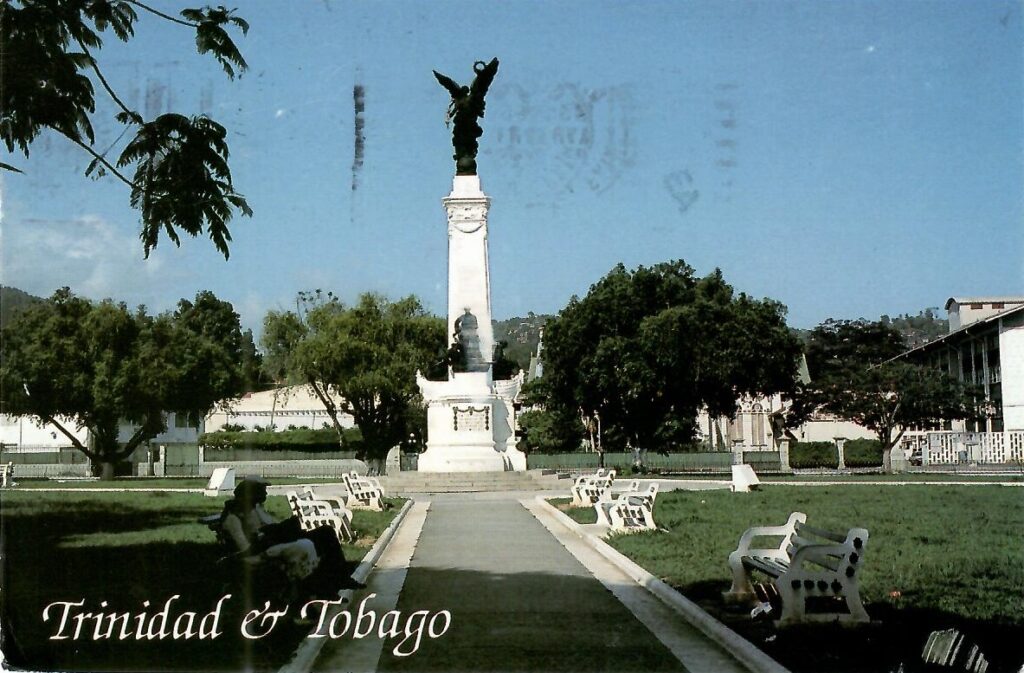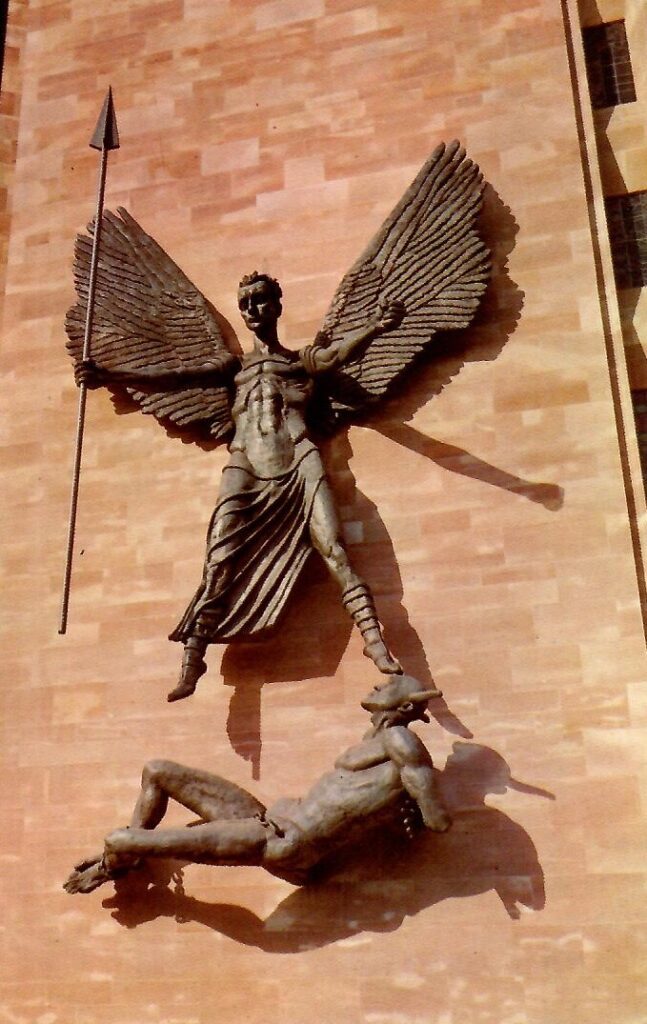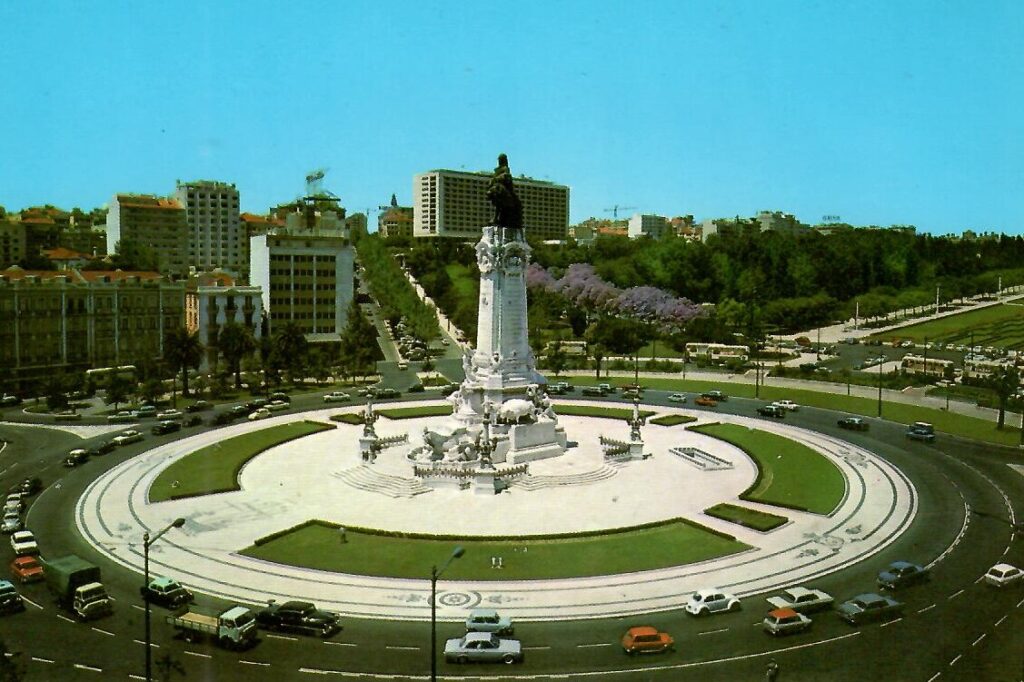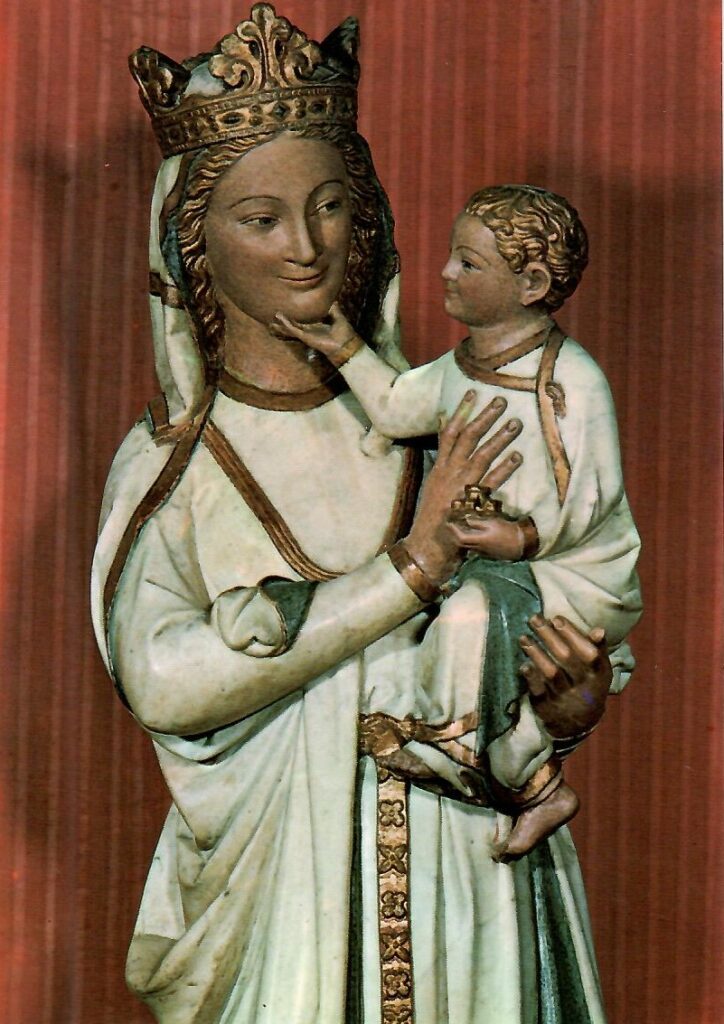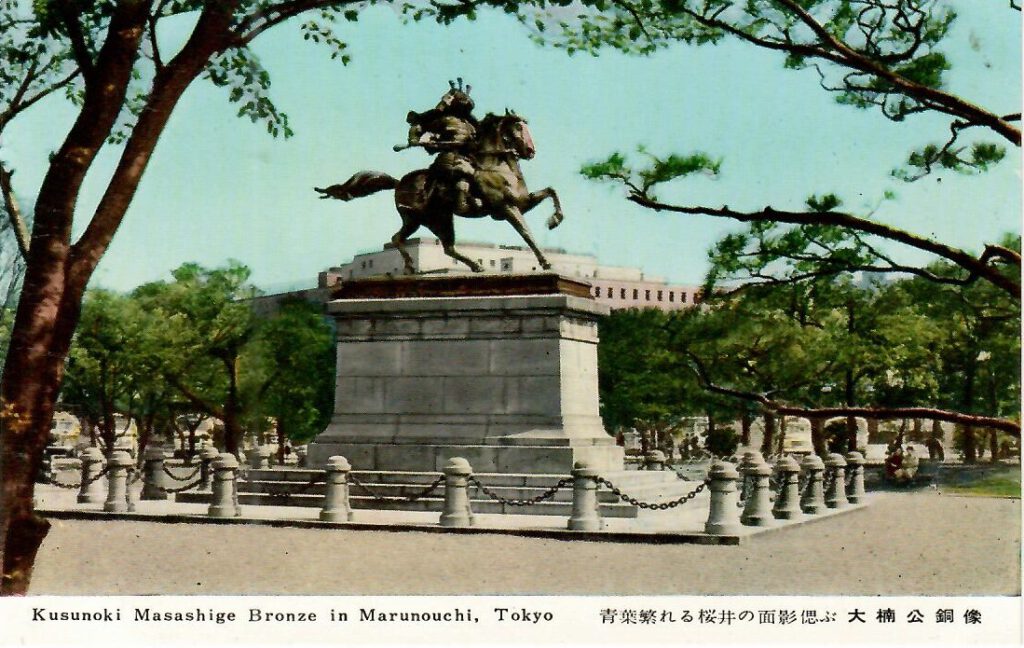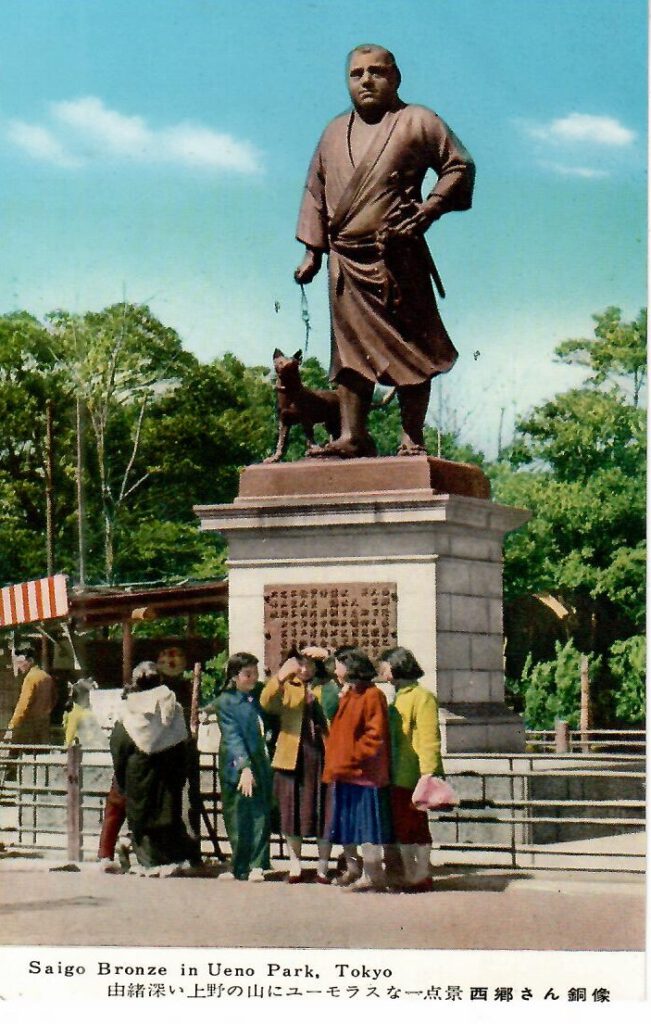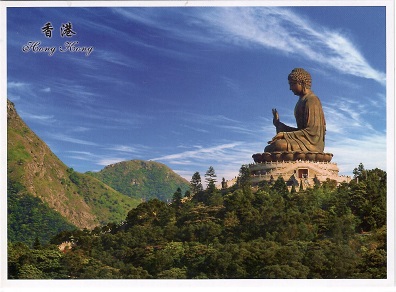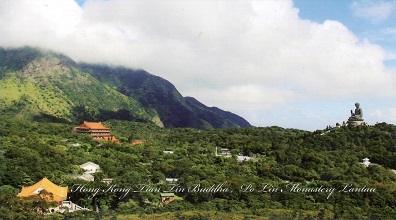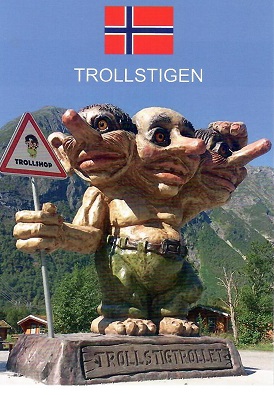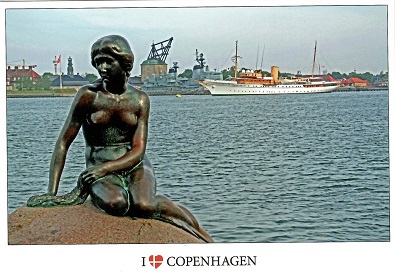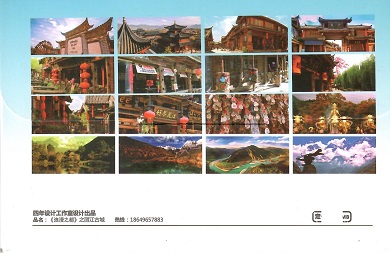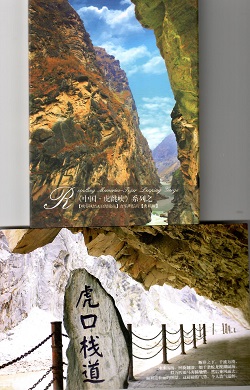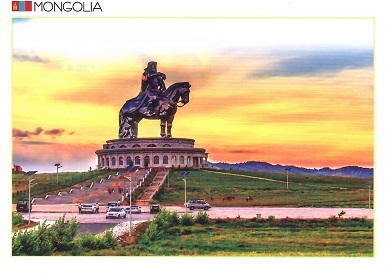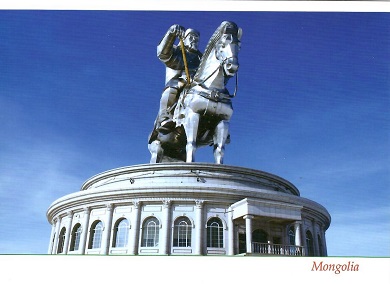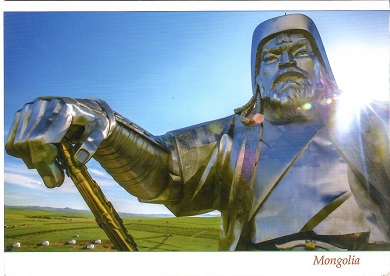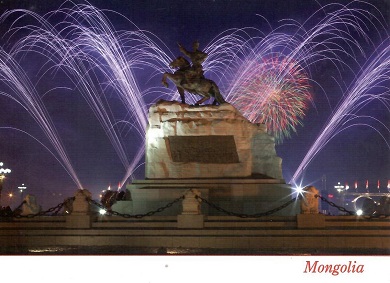-
Port-of-Spain, Memorial Park (Trinidad)
… and its statue, the Monument to the Brave, on a card mailed in 1996 (according to the sender) with stamp and postmark. Two points to note: first, a postal abrasion near the edge of the address area; and, second, that the postmark seems to be in error — printed in reverse, and even with the wrong year. Overlaid on all that is another postmark from Miami, even though it was addressed to Texas. As Americans might say, “Go figure.” Grade: 3
-
Coventry Cathedral, Epstein’s Statue (England)
To be precise, Epstein’s bronze statue of St. Michael and the Devil — on Cotman-Color card 19334, unused. Grade: 1
-
Lisbon, Praça do Marquês de Pombal (Portugal)
Otherwise called The Marquis of Pombal Square, an important roundabout located between the Avenida da Liberdade Eduardo VII Park. The Blue and Yellow lines of the Lisbon Metro stop at Marquês de Pombal station, which was called Rotunda until March 1998. Its name is a reference to Sebastião José de Carvalho e Melo, 1st Marquis of Pombal, 1st Count of Oeiras, the prime-minister who ruled Portugal from 1750 to 1777. Unused card. Grade: 1
-
Toledo, White Virgin (Spain)
Unused card. Grade: 1
-
Tokyo, Marunouchi, Kusunoki Masashige Bronze
Kusunoki Masashige (楠木 正成, 1294 – 1336) was a Japanese samurai of the Kamakura period remembered as the ideal of samurai loyalty. Kusunoki fought for Emperor Go-Daigo in the Genkō War to overthrow the Kamakura shogunate and restore power in Japan to the Imperial Court. He was a leading figure of the Kenmu Restoration in 1333, remained loyal to unpopular Emperor Go-Daigo after Ashikaga Takauji began to reverse the restoration in the Nanboku-chō wars three years later, attacked Takauji at the command of the Emperor — an act of obedience sure to result in defeat — and died at the Battle of Minatogawa. Kusunoki became a popular legend in Japan representing loyalty and virtue, and is associated with the phrase “Would that I had seven lives to give for my country!” Kusunoki was posthumously awarded the highest court rank in Japan, Senior First Rank, by the Meiji government in 1880. And of course his legend lives on within his imposing statue, as you see on this unused old card. Grade: 1
-
Tokyo, Ueno Park, Saigo Bronze (Japan)
Saigō Takamori (Takanaga) (西鄕 隆盛 (隆永), 1828 – 1877) was one of the most influential samurai in Japanese history and one of the three great nobles who led the Meiji Restoration. Historian Ivan Morris described him as “the quintessential hero of modern Japanese history” and this famous bronze statue of Saigō in hunting attire with his dog stands in Ueno Park. Made by Takamura Kōun, it was unveiled on December 18, 1898. Saigō met British diplomat Ernest Satow in the 1860s, as recorded in the latter’s A Diplomat in Japan, and Satow was present at the unveiling as recorded in his diary. This unused 1950s card is Grade: 1
-
Ngong Ping, The Big Buddha (Hong Kong)
Unused 5-1/8″ x 7″ card, and just FYI, Buddha is 34 meters high and weighs 250 tons. Grade: 1
-
Lantau, The Big Buddha 57 (Hong Kong)
Unused 5-1/8″ x 7″ card, and that “57” is the card’s own reference number. Grade: 1
-
Lantau, Tian Tin (sic) Buddha at Ngong Ping (Hong Kong)
Correctly spelled “Tian Tan” but nevertheless, lots to see on this unused, 4″ x 7-1/8″ card from 2017 and sourced at the site. Grade: 1
-
Lantau, Tian Tin (sic) Buddha, Po Lin Monastery (Hong Kong)
Correctly spelled Tian Tan, and appearing in this overview of the Ngong Ping 360 area on an unused, 4″ x 7-1/8″ card. Grade: 1
-
Trollstigen, statue (Norway)
See our Norway entry 20541087. This is also an unused card. Grade: 1
-
I (heart) Copenhagen, The Little Mermaid (Denmark)
And, as a bonus, the Royal Yacht Dannebrog, on this unused postcard. Grade: 1
-
Recalling Memories — Li Jiang (Set of 16) (Yunnan, PR China)
This is an unused set of big (4-3/4″ x 7-1/2″) cards showing everything of interest in or near Li Jiang. Our scan shows the back cover of the heavy paper cover, and therefore the cards, but the difference is that the cards themselves have printed captions on the fronts that identify the scenes in Chinese and also have dreamy, poetic comments in Chinese and English. It is a high-quality set, very Chinese in style, and one of these cards shows Yushuizhai. Grade: 1
-
Recalling Memories – Tiger Leaping Gorge (Set of 16) (Yunnan, PR China)
We’re not going into detail about Tiger Leaping Gorge, but it is a bucket-list item for every visitor to Yunnan. If you like rushing rivers, you’ll love this. The scan shows you the front cover and one of 16 unused 4-3/4″ x 7-1/2″ cards in the set. Each card has Chinese text on the front, that may or may not somehow connect to the scene but does not specifically say much about it. We went. It’s impressive in its way. Grade: 1
-
Tsonjin Boldog, Chinggis Khaan’s Complex (Mongolia)
Several KM away from Ulaanbaatar, we wouldn’t be too surprised if astronauts said they could see this from the Space Station. It’s massive. Unused Mongol Post card. Grade: 1
-
Töv Province (Tuv Aimag), Chinggis Khaan Statue Complex (Mongolia)
This is, apparently, the world’s tallest equestrian statue. Frankly, it’s hard to imagine there could be anything bigger. Unused Mongol Post card. Grade: 1
-
Töv Province (Tuv Aimag), Top of Chinggis Khaan Equestrian Statue (Mongolia)
Unused Mongol Post card. Grade: 1
-
Chinggis Khaan Monument Complex (Mongolia)
Unused. Grade: 1
-
Ulaanbaatar, Monument of Sukhbaatar (Mongolia)
From Mongol Post, we have two of these. One is unused (Grade: 1, $5) and the other was mailed from Ulaanbaatar in 2025 with two different stamps and postmark (Grade: 1, $8).

